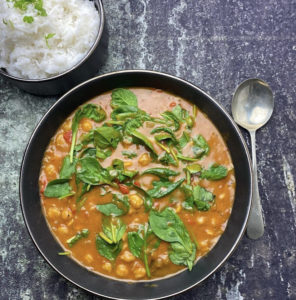This ancient practice is layered with interconnected elements that form part of its therapy, including diet.
In this article, we discuss why and how food and ingredients are critical to the practice.

What is Traditional Chinese Medicine?
Over thousands of years and throughout China and other parts of East Asia, Traditional Chinese Medicine has been practiced as a primary healthcare system.
The practice consists of theories and treatments that center around restoring balance within the body.
TCM highlights the human body as an interconnected system – mind, body, and environment. All three elements are part of diagnostics and the prescribed treatment plan.
Traditional Chinese Medicine involves a combination approach, including one or more of the following:
- Acupuncture
- Herbal medicine
- Dietary therapy
- Exercise plan (Think Tai chi)
- Moxibustion
How food plays a part in TCM
Within the TCM framework, food is an essential source of Qi, a person’s life force or energy. Nutrients are a key “medicine” for the body and its healthy functioning.
Different types of food impact the body’s balance in different ways. Therefore, the choice of foods and the way they are prepared influences the body’s Qi and overall health.
In TCM, foods from these two classifications:
- Their thermal makeup: heating, cooling, or neutral
- Their taste: sour, sweet, salty, bitter, or pungent
- Their movements: outwards, upwards, neutral, downwards and inwards
Within the concept of Yin and Yang the diet is advised based on Yin or Yang body constitution and including above classifications.
Each of these features links to a different or specific organ or area in the body.
For example, a slice of cooling cucumber will clear heat from the body to benefit it in hot weather or in the case of internal body heat.
Within the concept of Yin and Yang:
- Yin is more cooling and nourishing
- Yang is warming and energizing
Creating a balance between the two is critical.
What Are The Five Elements Of Food?
TCM recognizes the importance of the five elements in food. Each component links to a specific flavor and bodily organ.
- Wood
-
- Associated organs: Liver and gallbladder
- Flavor: sour foods
- Energetic qualities: Wood represents growth, flexibility, and the ability to adapt.
Examples of foods linked to this element:
- Citrus fruits: Oranges, lemons, and grapefruits.
- Sour berries: Berries like cranberries and raspberries have a slightly sour taste and are known for their antioxidant properties and ability to support liver health.
- Vinegar: Various types of vinegar, such as apple cider vinegar and rice vinegar.
- Fermented foods: Foods like sauerkraut, pickles, and kimchi have a sour and tangy flavor due to fermentation.
- Sour greens: Vegetables like dandelion greens, mustard greens, and sorrel have a slightly bitter and sour taste.
- Sour herbs and spices: Such as tamarind, lemon balm, and green sour plum.
- Fire
-
- Associated organs: Heart and small intestine
- Flavor: bitter
- Energetic qualities: Fire represents warmth, transformation, and vitality.
Examples of foods linked to this element:
- Leafy greens: Bitter greens like kale, arugula, and dandelion greens.
- Dark chocolate: High-quality dark chocolate with a high cocoa content can taste bitter.
- Coffee: Has a naturally bitter flavor, stimulates the heart, and invigorates the mind.
- Green tea: Certain types of green tea, such as matcha and sencha, have a slightly bitter taste.
- Citrus peel: The peel of citrus fruits, such as oranges and lemons.
- Medicinal herbs: Various bitter herbs, such as gentian root, chamomile, and dandelion root.
- Earth
-
- Associated organs: Spleen and stomach
- Flavor: Sweet
- Energetic qualities: Earth represents stability, nourishment, and grounding.
Examples of foods linked to this element:
- Whole grains: Nourishing whole grains like rice, oats, quinoa, and barley.
- Sweet root vegetables: Sweet potatoes, carrots, parsnips, and beets have a natural sweetness and nourishes the Earth element.
- Legumes: Beans, lentils, and peas are considered sweet and are rich in fiber and plant-based protein.
- Fruits: Ripe fruits like bananas, dates, figs, and sweet apples are associated with the Earth element and provide natural sweetness, vitamins, minerals, and fiber.
- Honey: Pure, raw honey is considered a sweetener that is gentle on the spleen and stomach.
- Nuts and seeds: Almonds, walnuts, sesame, and pumpkin seeds have a subtle sweetness.
- Warm spices: Spices like cinnamon, nutmeg, and ginger add a sweet and warming quality to dishes.
- Metal
-
- Associated organs: Lung and large intestine
- Flavor: Spicy/pungent
- Energetic qualities: Metal represents clarity, strength, and purity.
Examples of foods linked to this element:
- Garlic and onions: Both garlic and onions have a strong and pungent flavor.
- Ginger: Ginger has a spicy and warming taste.
- Radishes: Radishes have a sharp and pungent taste.
- Mustard greens
- Horseradish
- Cayenne pepper: Cayenne pepper is a spicy seasoning that stimulates circulation and promotes warmth in the body.
- Peppermint: Peppermint has a cooling and pungent flavor.
- Radish leaves: The leaves of radishes have a peppery and pungent taste.
- Water
- Associated organs: Kidney and bladder
- Flavor: Salty
- Energetic qualities: Water represents wisdom, adaptability, and the storage of reserves. It is associated with the winter season and symbolizes introspection, deep emotions, and the source of life.
Examples of foods linked to this element:
- Sea vegetables: Seaweed, kelp, and nori are rich in minerals and have a naturally salty taste.
- Seafood: Fish and shellfish, such as salmon, mackerel, shrimp, and clams.
- Miso: These fermented soybeans have a salty flavor.
- Salt: In moderation, high-quality sea salt or mineral-rich salts like Himalayan salt enhance the flavor of dishes and provide a natural source of saltiness.
- Black Beans: Black beans have a mild saltiness.
- Bone Broth: Homemade bone broth made from animal bones and connective tissues contains trace minerals and has a slightly salty taste.
- Dulse: A kind of red seaweed, dulse has a salty flavor and is rich in vitamins and minerals.
Wrapping It Up
We hope this article sheds some light on how food and ingredients are viewed and used within Traditional Chinese Medicine.
There is so much information to share, this article has scratched the surface, but we look forward to sharing more with you.


